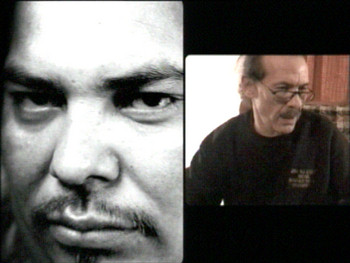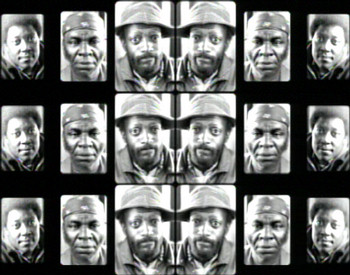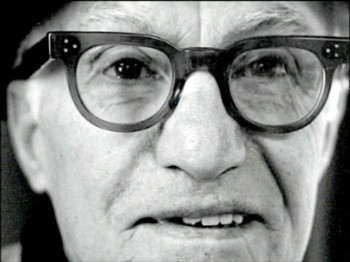Terminal Bar
 The guy who dominates Stefan Nadelman’s documentary short Terminal Bar could be related to Robert Crumb, both in his physical features and his matter-of-fact way. He talks about everything from death by alcohol to bathroom blowjobs to the “destituted” people who frequented the titular establishment where he tended bar for a decade. And like the famous cartoonist Crumb, he seems perpetually amused, and it looks suspiciously like a defense mechanism.
The guy who dominates Stefan Nadelman’s documentary short Terminal Bar could be related to Robert Crumb, both in his physical features and his matter-of-fact way. He talks about everything from death by alcohol to bathroom blowjobs to the “destituted” people who frequented the titular establishment where he tended bar for a decade. And like the famous cartoonist Crumb, he seems perpetually amused, and it looks suspiciously like a defense mechanism.
He tells of putting cheap liquor in the bottles of more expensive brands, and brags that not one person ever noticed.
In talking about the clientele, he says that the white, working-class patrons died off – often because of booze – and were replaced by gay black men. With a shrug, without bitterness or judgment, he says something along the lines of: If you become a gay bar, you become a gay bar. Whatcha gonna do?
His name is Sheldon Nadelman. He is not the subject of the 23-minute movie, but its character is drawn from him: lively, detailed, aloof, unfocused, and scattershot.
Those last two adjectives would normally be a criticism, but not here. Terminal Bar is not artful, but its slapdash form is an appropriate reflection of Sheldon Nadelman’s style and tone, and his vivid memories of Terminal Bar, once called New York’s toughest tavern.
 Like Tarnation, Terminal Bar is energetic and charmingly amateurish. In both cases, the filmmakers overuse consumer editing/effects tools, but rather than appearing pathetic, their methods create a hypnotic visual framework.
Like Tarnation, Terminal Bar is energetic and charmingly amateurish. In both cases, the filmmakers overuse consumer editing/effects tools, but rather than appearing pathetic, their methods create a hypnotic visual framework.
But while Tarnation – both in style and content – was deeply personal, Terminal Bar is merely idiosyncratic, because the movie has no apparent connection to the filmmaker’s own life. There are several filters/barriers between its true subjects – bar patrons – and the audience.
Sheldon Nadelman (who might be the filmmaker’s father, and is at the least a close relative) serves as a tour guide, and if I’m understanding the chronology, at least a decade has passed between the closure of Terminal Bar and his interview being filmed. The barflies are never even heard in Terminal Bar, and we have no way of knowing whether Sheldon’s recollections of them are remotely accurate.
 All we have of those customers are photographs that Sheldon took, and he took thousands of them. Those black-and-white stills are fabulously unguarded and empathetic, and they need no adornment. Frankly, they don’t need Sheldon’s chatter, either, or Stefan’s constant movement.
All we have of those customers are photographs that Sheldon took, and he took thousands of them. Those black-and-white stills are fabulously unguarded and empathetic, and they need no adornment. Frankly, they don’t need Sheldon’s chatter, either, or Stefan’s constant movement.
They only need to be seen.
And in them, you can even glimpse Sheldon’s true character. He acts like he doesn’t care, but there is love in these portraits. The way he tells it, Terminal Bar’s patrons were merely drunks, but those pictures reveal humanity.
So while I enjoy the verve of Terminal Bar, I would have preferred a quieter, calmer technique that did justice to those photographs, that gave the audience the time to focus on those faces. I want to study and get to know these people, even though I’ll never be able to hear their voices.
An excerpt:
(This essay is a contribution to the Short-Film Week blog-a-thon. Terminal Bar can be found on Best of RESFEST Shorts, Volume 3.)


That’s funny that the photographic technique was what you least liked about the film. I have the REsFest dvd this shows up on, and I remember being shown it in documentary class as an example of the creative potential of still photos. I assume the post-production trickery is mainly why people have heard of the film.
Short: I wouldn’t say that’s what I liked least, but I think the technique got in the way of what was most compelling.
I’m guessing you’re right that the “creativity” of the presentation got it noticed, and I’m afraid that’s just how things work. An austere, thoughtful treatment would have made a better movie, I think, but it would have fallen through the cracks.
I clicked through to this review and after reading your views that it was “not artful” and overused “consumer editing/effects tools” I was intending to comment to call you pretentious. Then I noticed the blog name. Haha, carry on mate!